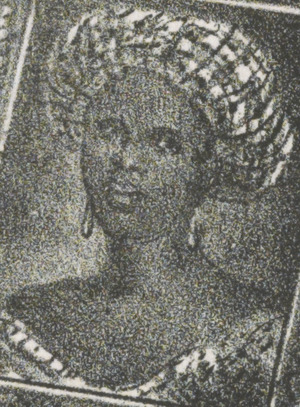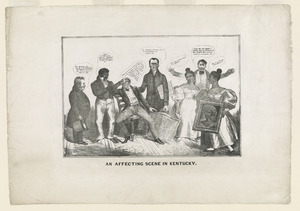Julia Chinn facts for kids
Quick facts for kids
Julia Chinn
|
|
|---|---|

Caricature of Julia Chinn, which deliberately over-emphasizes her African heritage – excerpted from 'An affecting scene in Kentucky' (see below)
|
|
| Born | c. 1790 |
| Died | July 1833 (aged 36–43) near George Town, Kentucky
|
| Occupation | Plantation manager; wife |
| Spouse(s) | Richard Mentor Johnson |
| Children | 2 |
Julia Chinn (around 1790 – July 1833) was an American woman who managed a large farm. She was also an enslaved person with mixed European and African heritage. Julia Chinn lived with Richard Mentor Johnson, who later became the ninth Vice President of the United States. Even though they could not legally marry at the time, Johnson treated her as his wife.
Contents
Early Life of Julia Chinn
Julia Chinn was born in Scott County, Kentucky. Her mother was an enslaved woman who belonged to the Johnson family. We don't know her exact birth date, but some records suggest it was around 1790. Other accounts say she might have been born in 1796 or 1797.
Julia grew up and was educated in the home of Richard Mentor Johnson. His mother, Jemima Suggett Johnson, taught her. Local stories say Julia's mother was named Henrietta. Because Julia was enslaved, she could not choose her own relationships.
Julia and Richard Mentor Johnson had two daughters. Their first daughter, Adaline Chinn Johnson, was born in 1812. A few years later, their second daughter, Imogene Chinn Johnson, was born. At that time, laws made it illegal for people of different races to marry. Also, Johnson was not required to claim his children. However, he insisted that his daughters use his last name. He also made sure they went to the Choctaw Academy, a school he started. In 1815, Johnson inherited Julia Chinn after his father passed away. He openly treated her as his wife, which was very unusual for the time.
Managing Blue Spring Farm
Richard Mentor Johnson was a politician who served in the United States House of Representatives. This meant he was often away from his home and businesses. While he was gone, Julia Chinn was in charge of everything. She managed the household and the entire farm. She also handled all the business matters. Johnson ordered his workers, including white employees, to obey Julia. This was very uncommon because she was an enslaved woman.
Julia Chinn was the main person running the Blue Springs farm. She oversaw the enslaved workers and managed the house and garden. She also took care of the tavern and mills on the farm. Julia planned parties and events, which were important for Johnson's political life. She also made sure their children were educated. People said she played the piano very well.
Julia was in charge of the farm's money and credit. She worked as Johnson's estate manager and his wife. She could use his accounts and open credit lines to buy things in his name. She also managed the cash Johnson left for the farm each year. This money paid the white workers, including teachers at the Choctaw Academy. Being in charge of so much money was very unusual for an enslaved woman at that time. Julia's role also helped her family. Her brother Daniel and his sons worked in the house. However, their safety was not guaranteed. In 1821, Johnson used Daniel and his wife as collateral for a loan to pay off debts.
Not everyone on the farm liked Julia being in charge. Some enslaved men who worked in the fields would skip work or refuse their tasks. When Julia asked male neighbors to help punish these men, they refused.
Choctaw Academy
In 1825, Richard Mentor Johnson opened a school for Native American boys. This school was on his Blue Springs farm. While Johnson was away, Julia Chinn managed the school. She paid the teachers and also worked as a nurse for the students. The Native American students paid for their schooling. Some students did not like that Julia would tell Johnson or the teachers about their misbehavior.
Later Life and Death
In 1833, a serious illness called cholera spread in the area. The Choctaw Academy also had an outbreak. Julia Chinn cared for many of the sick boys. Sadly, she caught the disease herself and died in July 1833. We do not know where she was buried.
When Julia died, her daughters were legally considered enslaved people because their mother was enslaved. Even though Johnson never freed Julia, he did free their surviving daughter.
Julia Chinn's Legacy
Throughout her life, Julia Chinn took on many duties like a politician's wife. When the Marquis de Lafayette, a famous French general, visited the farm, Julia helped plan the events. She organized entertainment both at the farm and in the local area. This required a lot of planning and managing relationships with the white political community.
Johnson's time in the Senate ended in 1828. He was not chosen to run for vice president with Andrew Jackson. It seems his relationship with Julia Chinn was a reason for this. People worried it could harm the president's reputation.
After Julia Chinn died, Johnson ran for vice president with Martin Van Buren, who became the eighth president. Johnson was elected. However, during the campaign, many cartoons and papers were published that criticized Johnson because of his relationship with Julia and their daughters. One cartoon from 1836 showed Johnson with his two daughters. One daughter held a picture of Julia. A caption read: "When I read the mean attacks in the Newspapers on the Mother of my Children, forgive me, my friends if I feel sad!!! My dear Girls, bring me your Mother's picture, so I can show it to my friends here." In the cartoon, Julia and her daughters' skin color was made darker on purpose. Julia likely had much lighter skin than shown. The cartoon also showed her wearing a turban to make her seem "different."
Historical Information
No writings from Julia Chinn or her daughters have survived. Historian Amrita Myers believes that Johnson's brothers destroyed many of his old papers after he died. They might have done this for two reasons. First, they wanted to prevent his daughters from inheriting his property, even though he had named them in his will. Second, they were ashamed of his relationship with Julia Chinn.
In 2020, people in Johnson County, Iowa, discussed changing the county's name. They wanted to remove its connection to Richard Mentor Johnson. Reasons included Johnson's actions in battles, like killing Tecumseh, and his owning of many enslaved people, including Julia Chinn.
Literature
Julia Chinn and Richard Mentor Johnson are characters in the novel Great Crossing, written by Judalon de Bornay.
See also
 In Spanish: Julia Chinn para niños
In Spanish: Julia Chinn para niños


